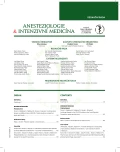Echocardiographic examination in mitral valve disease
Authors:
J. Kunstýř 1; H. Línková 2
Authors‘ workplace:
Klinika anesteziologie, resuscitace a intenzivní medicíny, VFN a 1. LF UK v Praze
1; III. interní – kardiologická klinika FNKV a 3. LF UK v Praze
2
Published in:
Anest. intenziv. Med., 27, 2016, č. 3, s. 181-186
Category:
Overview
Mitral valve disease plays an important role in the aetiology of cardiac failure. It may present as a serious, life-threatening condition necessitating intensive care. Echocardiography is one of the most important diagnostic tools, nowadays widely used not only by cardiologists but also by anaesthetists and intensivists. The authors present basic echocardiographic methods used in patients with mitral valve disease.
Keywords:
echocardiography – mitral valve
Sources
1. Nkomo, V. T., Gardin, J. M., Skelton, T. N. et al. Burden of valvular heart diseases: a population-based study. Lancet, 2006, 368, p. 1005–1011.
2. Iung, B., Baron, G., Butchart, E. G. et al. A prospective survey of patients with valvular heart disease in Europe: The Euro Heart Survey on Valvular Heart Disease. Eur. Heart. J., 2003, 24, p. 1231–1243.
3. Enriquez-Sarano, M., Akins, C. W., Vahanian, A. Mitral regurgitation. Lancet, 2009, 373, p. 1382–1394.
4. Vahanian, A., Alfieri, O., Andreotti, F., Antunes, M. et al. Guidelines on the management of valvular heart disease (version 2012): the Joint Task Force on the Management of Valvular Heart Disease of the European Society of Cardiology (ESC) and the European Association for Cardio-Thoracic Surgery (EACTS). Eur. Heart. J., 2012, 33, p. 2451–2496.
5. Klein, A. A., Snell, A., Nashef, S. A., Hall, R. M., Kneeshaw, J. D., Arrowsmith, J. E. The impact of intra-operative transoesophageal echocardiography on cardiac surgical practice. Anaesthesia, 2009, 64, 9, p. 947–952.
6. Lancellotti, P., Tribouilloy, C., Hagendorff, A. et al. Recommendations for the echocardiographic assessment of native valvular regurgitation: an executive summary from the European Association of Cardiovascular Imaging. Eur. Heart J. Cardiovasc. Imaging, 2013, 14, p. 611–644.
7. Lancelloti, P., Moura, L., Pierard, L. A. et al. European Association of Echocardiography recommendations for the assessment of valvular regurgitation. Part 2: mitral and tricuspid regurgitation (native valve disease). Eur. J. Echocardio., 2010, 11, p. 307–332.
8. Marijon, E., Ou, P., Celermajer, D. S. et al. Prevalence of rheumatic heart disease detected by echocardiographic screening. N. Engl. J. Med., 2007, 357, p. 470–476.
9. Lang, R. M., Badano, L. P., Tsang, W. et al. EAE/ASE recommendations for image acquisition and display using three-dimensional echocardiography. J. Am. Soc. Echocardiogr., 2012, 25, p. 3–46.
10. Baumgartner, H., Hung, J., Barmejo, J. et al. Echocardiographic assessment of valve stenosis: EAE/ASE recommendations for clinical practice. Eur. J. Echocardio., 2009, 10, p. 1–25.
11.Thomas, J. D., Weyman, A. E. Doppler mitral pressure half-time: a clinical tool in search of theoretical justification. J. Am. Coll. Cardiol., 1987, 10, p. 923–929.
12. Ward, C., Hancock, B. W. Extreme pulmonary hypertension caused by mitral valve disease: natural history and results of surgery. Br. Heart. J., 1975, 37, p. 74–78.
Labels
Anaesthesiology, Resuscitation and Inten Intensive Care MedicineArticle was published in
Anaesthesiology and Intensive Care Medicine

2016 Issue 3
Most read in this issue
- Pleural effusion in intensive care
- Tracheal damage as a consequence of percutaneous dilatation tracheostomy – case reports and review of literature
- Echocardiographic examination in mitral valve disease
- The role of simulation in the evolution of anaesthesia and intensive care medicine
